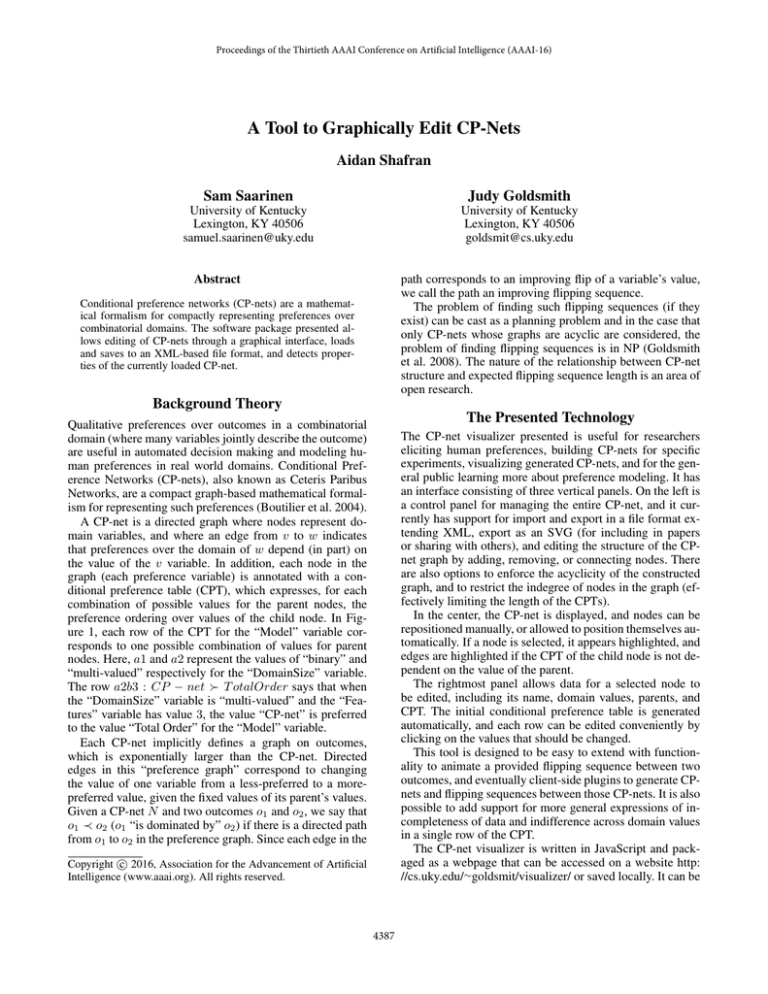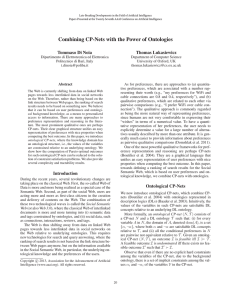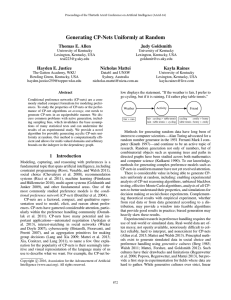
Proceedings of the Thirtieth AAAI Conference on Artificial Intelligence (AAAI-16)
A Tool to Graphically Edit CP-Nets
Aidan Shafran
Sam Saarinen
Judy Goldsmith
University of Kentucky
Lexington, KY 40506
samuel.saarinen@uky.edu
University of Kentucky
Lexington, KY 40506
goldsmit@cs.uky.edu
path corresponds to an improving flip of a variable’s value,
we call the path an improving flipping sequence.
The problem of finding such flipping sequences (if they
exist) can be cast as a planning problem and in the case that
only CP-nets whose graphs are acyclic are considered, the
problem of finding flipping sequences is in NP (Goldsmith
et al. 2008). The nature of the relationship between CP-net
structure and expected flipping sequence length is an area of
open research.
Abstract
Conditional preference networks (CP-nets) are a mathematical formalism for compactly representing preferences over
combinatorial domains. The software package presented allows editing of CP-nets through a graphical interface, loads
and saves to an XML-based file format, and detects properties of the currently loaded CP-net.
Background Theory
The Presented Technology
Qualitative preferences over outcomes in a combinatorial
domain (where many variables jointly describe the outcome)
are useful in automated decision making and modeling human preferences in real world domains. Conditional Preference Networks (CP-nets), also known as Ceteris Paribus
Networks, are a compact graph-based mathematical formalism for representing such preferences (Boutilier et al. 2004).
A CP-net is a directed graph where nodes represent domain variables, and where an edge from v to w indicates
that preferences over the domain of w depend (in part) on
the value of the v variable. In addition, each node in the
graph (each preference variable) is annotated with a conditional preference table (CPT), which expresses, for each
combination of possible values for the parent nodes, the
preference ordering over values of the child node. In Figure 1, each row of the CPT for the “Model” variable corresponds to one possible combination of values for parent
nodes. Here, a1 and a2 represent the values of “binary” and
“multi-valued” respectively for the “DomainSize” variable.
The row a2b3 : CP − net T otalOrder says that when
the “DomainSize” variable is “multi-valued” and the “Features” variable has value 3, the value “CP-net” is preferred
to the value “Total Order” for the “Model” variable.
Each CP-net implicitly defines a graph on outcomes,
which is exponentially larger than the CP-net. Directed
edges in this “preference graph” correspond to changing
the value of one variable from a less-preferred to a morepreferred value, given the fixed values of its parent’s values.
Given a CP-net N and two outcomes o1 and o2 , we say that
o1 ≺ o2 (o1 “is dominated by” o2 ) if there is a directed path
from o1 to o2 in the preference graph. Since each edge in the
The CP-net visualizer presented is useful for researchers
eliciting human preferences, building CP-nets for specific
experiments, visualizing generated CP-nets, and for the general public learning more about preference modeling. It has
an interface consisting of three vertical panels. On the left is
a control panel for managing the entire CP-net, and it currently has support for import and export in a file format extending XML, export as an SVG (for including in papers
or sharing with others), and editing the structure of the CPnet graph by adding, removing, or connecting nodes. There
are also options to enforce the acyclicity of the constructed
graph, and to restrict the indegree of nodes in the graph (effectively limiting the length of the CPTs).
In the center, the CP-net is displayed, and nodes can be
repositioned manually, or allowed to position themselves automatically. If a node is selected, it appears highlighted, and
edges are highlighted if the CPT of the child node is not dependent on the value of the parent.
The rightmost panel allows data for a selected node to
be edited, including its name, domain values, parents, and
CPT. The initial conditional preference table is generated
automatically, and each row can be edited conveniently by
clicking on the values that should be changed.
This tool is designed to be easy to extend with functionality to animate a provided flipping sequence between two
outcomes, and eventually client-side plugins to generate CPnets and flipping sequences between those CP-nets. It is also
possible to add support for more general expressions of incompleteness of data and indifference across domain values
in a single row of the CPT.
The CP-net visualizer is written in JavaScript and packaged as a webpage that can be accessed on a website http:
//cs.uky.edu/∼goldsmit/visualizer/ or saved locally. It can be
c 2016, Association for the Advancement of Artificial
Copyright Intelligence (www.aaai.org). All rights reserved.
4387
Figure 1: Here, the “Model” node is selected.
References
run in most web browsers on most platforms. It uses multiple third-party open-source JavaScript libraries, including
D3 and WebCoLa. D3 provides Scalable Vector Graphic
(SVG) rendering capabilities, and WebCoLa provides the
constraint-based physics engine used to position the nodes
in the graph. The visualizer is provided open-source and free
of charge under the MIT License, as are most of the thirdparty libraries it uses.
Allen, T. E.; Goldsmith, J.; Justice, H. E.; Mattei, N.; and
Raines, K. 2016. Generating CP-nets uniformly at random.
In Proc. AAAI.
Boutilier, C.; Brafman, R. I.; Domshlak, C.; Hoos, H. H.;
and Poole, D. 2004. CP-nets: A tool for representing and
reasoning with conditional ceteris paribus preference statements. Journal of Artificial Intelligence Research 21:135–
191.
Goldsmith, J.; Lang, J.; Truszczynski, M.; and Wilson, N.
2008. The computational complexity of dominance and consistency in CP-nets. Journal of Artificial Intelligence Research 33:403–432.
Purpose of the Demonstration
We will demonstrate the current functionalities of the CP-net
visualizer, including its use for eliciting human preferences
and visualizing generated CP-nets. This tool is designed to
be easy to extend. For instance, Allen et al. (Allen et al.
2016) have code for generating CP-nets uniformly at random, given the number of nodes and, optionally, bounds on
in-degree. We will be enabling client-side plugins for that
code, and for code to find and animate flipping sequences.
Support can be added for learning CP-nets, and for handling
incomplete CPTs and indifference across domain values in
a single row of a CPT.
The demonstration is designed to make this tool known
and available to researchers around the world who are working with CP-nets, both for research purposes and for outreach. An easy-to-understand tool like the one presented will
make it easier to communicate with the public about work
in understanding decision-making, and will make the mathematical models used by researchers more accessible to the
general public.
4388












